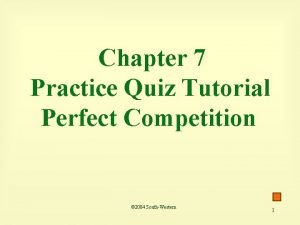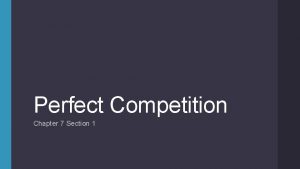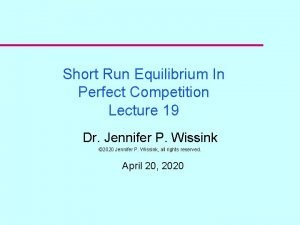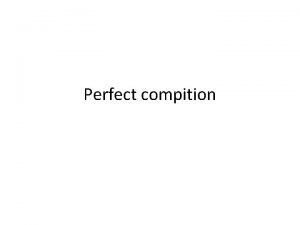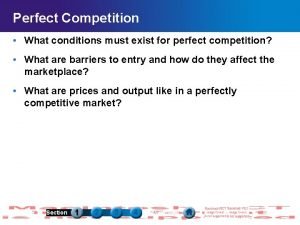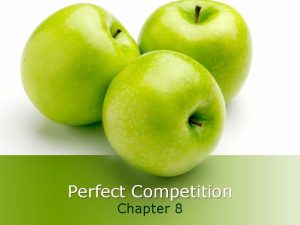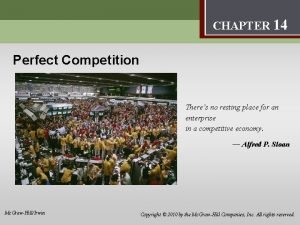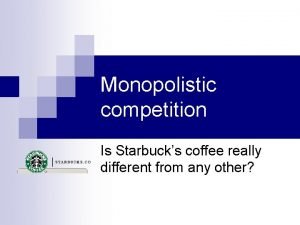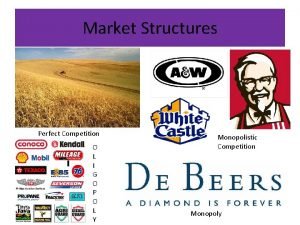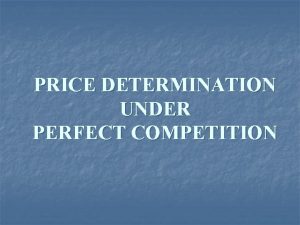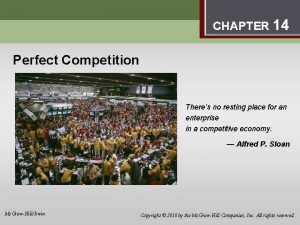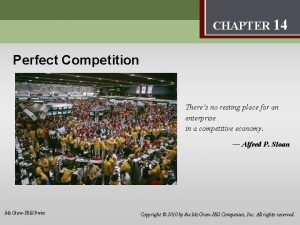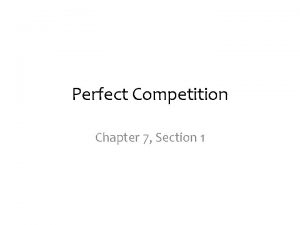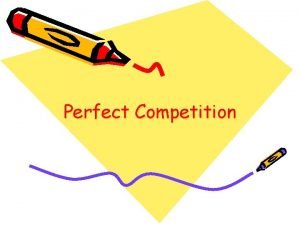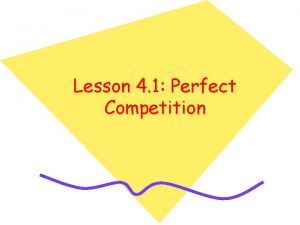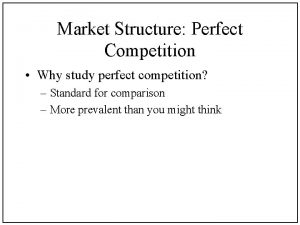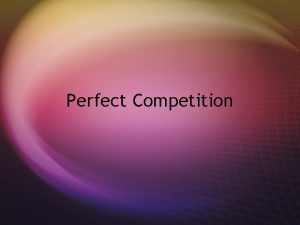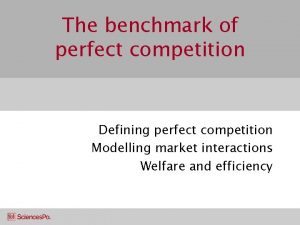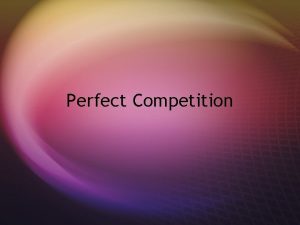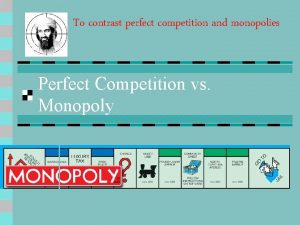Chapter 7 Practice Quiz Tutorial Perfect Competition 2004


















- Slides: 18

Chapter 7 Practice Quiz Tutorial Perfect Competition © 2004 South-Western 1

1. A perfectly competitive market is not characterized by a. many small firms. b. a great variety of different products. c. free entry into and exit from the market. d. any of the above. B. Perfect competition is characterized by goods that cannot be distinguished from one another. 2

2. Which of the following is a characteristic of perfect competition? a. Entry barriers. b. Homogeneous products. c. Expenditures on advertising. d. Quality of service. B. A homogeneous product is one that cannot be distinguished from the others, for example, one potato looks just like another potato. 3

3. Which of the following are the same at all levels of output under perfect competition? a. Marginal cost and marginal revenue. b. Price and marginal revenue. c. Price and marginal cost. d. All of the above. B. Price equals marginal revenue because each unit is sold at the same price; therefore, every additional unit sold adds the price to total revenue. 4

4. If a perfectly competitive firm sells 100 units of output at a market price of $100 per unit, its marginal revenue per unit is a. $1. b. $100. c. more than $1, but less than $100. d. less than $100. B. Marginal revenue is defined as the addition to total revenue when selling one unit. 5

5. Short-run profit maximization for a perfectly competitive firm occurs when the firm’s marginal cost equals a. average total cost. b. average variable cost. c. marginal revenue. d. all of the above. C. Profits are maximized or losses are minimized at the unit of output where MR = MC. If MR were > than MC, an additional unit would be produced. If MR were < MC, that last unit would not be produced. 6

6. A perfectly competitive firm sells its output for $100 per unit, and the minimum average variable cost is $150 per unit. The firm should a. increase output. b. decrease output, but not shut down. c. maintain its current rate of output. d. shut down. D. At this output a firm’s losses exceed its fixed costs; it would therefore lose more money by staying open than by closing down. 7

Price & Cost per unit $80 $70 $60 $50 $40 $30 $20 $10 Short-Run Shutdown MR=MC MC ATC AVC P=MR=AR 1 2 3 4 5 6 7 8 9 8

7. A perfectly competitive firm’s supply curve follows the upward sloping segment of its marginal cost curve above the a. average total cost curve. b. average variable cost curve. c. average fixed cost curve. d. average price curve. B. The supply curve does not extend below the AVC curve because below this price the firm would close down; there would not be a supply curve. 9

P $15 $10 $5 Exhibit 7 -12 Price & Cost per unit $20 MC D C B ATC AVC A 500 1, 000 1, 500 2, 000 Q 10

8. Assume the price of the firm’s product in Exhibit 7 -12 is $15 per unit. The firm will produce a. 500 units per week. b. 1, 000 units per week. c. 1, 500 units per week. d. 2, 000 units per week. e. 2, 500 units per week. D. This is the number of units in which MR = MC. 11

9. The lowest price in Exhibit 7 -12 at which the firm earns zero economic profit in the short-run is a. $5 per unit. b. $10 per unit. c. $20 per unit. d. $30 per unit. B. This is the minimum point of the ATC curve at which P = ATC. Exactly a normal profit is being made, that is, zero economic profit. 12

10. Assume the price of the firm’s product in Exhibit 7 -12 is $6 per unit. The firm should a. continue to operate because it is earning an economic profit. b. stay in operation for the time being even though it is making an economic loss. c. shut down temporarily. d. shut down permanently. B. At this price, the firm’s losses are less than its fixed costs; it will therefore lose less money by staying open than closing. 13

11. Assume the price of the firm’s product in Exhibit 7 -12 is $10 per unit. The maximum profit the firm earns is a. zero. b. $5, 000 per week. c. $1, 500 per week. d. $10, 500 per week. A. In perfect competition, Price = AR = MR = the firm’s short-run demand curve. When P = ATC, the firm’s revenues equal its costs, so zero economic profits are made. Normal profit is included as a part of the firm’s cost data because it is a necessary expense of operating the business. 14

12. In Exhibit 7 -12, the firm’s total revenue at a price of $10 per unit pays for a. a portion of total variable costs. b. a portion of total fixed costs. c. none of the total fixed costs. d. all of the total fixed costs and total variable costs. D. At a price of $10, the firm is making an economic profit - more than enough money is being made to meet its fixed costs. 15

13. As shown in Exhibit 7 -12, the short-run supply curve for this firm corresponds to which segment of its marginal cost curve? a. A to D and all points above. b. B to D and all points above. c. C to D and all points above. d. B to C only. B. A supply curve shows how many units will be produced at various prices. The firm’s supply curve is its MC curve which lies above its AVC curve because it will always produce where MR (AR, P) = MC. 16

14. In long-run equilibrium, the perfectly competitive firm’s price equals which of the following? a. Short-run marginal cost. b. Minimum short-run average total cost. c. Marginal revenue. d. All of the above. D. Long-run equilibrium is at the price in which a normal profit is being made. Normal profit is when P(AR) = ATC in long-run equilibrium. 17

END 18
 Characteristics of monopoly
Characteristics of monopoly Perfect competition vs monopolistic competition
Perfect competition vs monopolistic competition Perfect competition vs monopolistic competition
Perfect competition vs monopolistic competition Perfect competition quiz
Perfect competition quiz Pure competition vs monopolistic competition venn diagram
Pure competition vs monopolistic competition venn diagram Chapter 7 section 1 perfect competition worksheet answers
Chapter 7 section 1 perfect competition worksheet answers Verbo to be present perfect
Verbo to be present perfect Perfect competition side by side graphs
Perfect competition side by side graphs Long run perfect competition equilibrium
Long run perfect competition equilibrium Long run supply curve
Long run supply curve Perfect compition
Perfect compition Barriers to entry for perfect competition
Barriers to entry for perfect competition Long run profit in perfect competition
Long run profit in perfect competition Perfect competition advantages
Perfect competition advantages Perfect competition 4 conditions
Perfect competition 4 conditions Shut down point
Shut down point Is starbucks an oligopoly or monopolistic competition
Is starbucks an oligopoly or monopolistic competition Example of pure competition
Example of pure competition Perfect competition examples
Perfect competition examples



